2012 HYUNDAI IX35 service
[x] Cancel search: servicePage 328 of 560
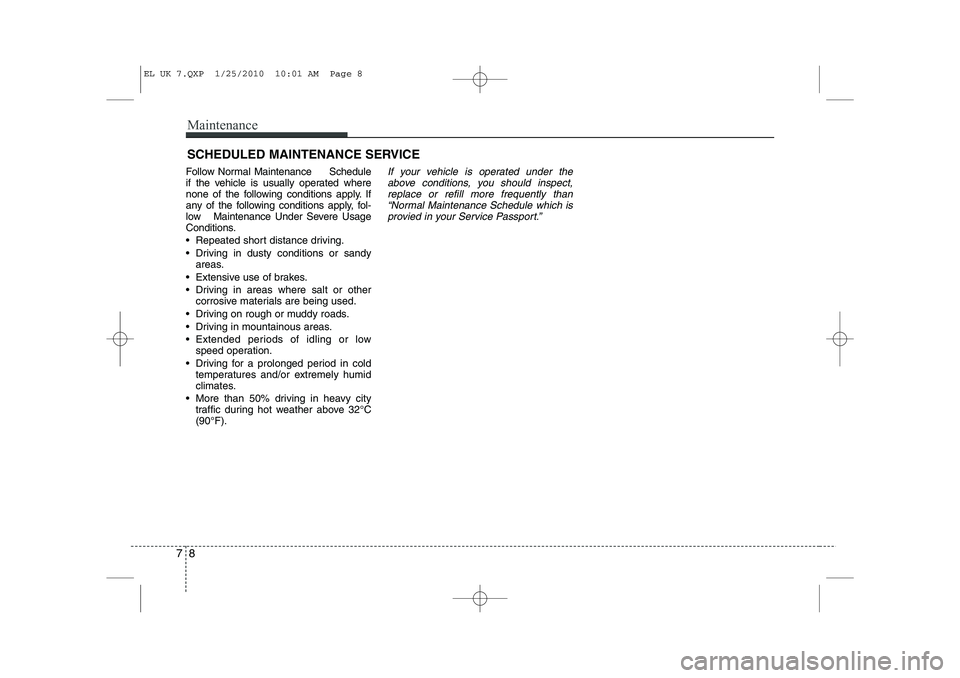
Maintenance
8
7
SCHEDULED MAINTENANCE SERVICE
Follow Normal Maintenance Schedule
if the vehicle is usually operated where
none of the following conditions apply. If
any of the following conditions apply, fol-
low Maintenance Under Severe Usage
Conditions.
Repeated short distance driving.
Driving in dusty conditions or sandy areas.
Extensive use of brakes.
Driving in areas where salt or other corrosive materials are being used.
Driving on rough or muddy roads.
Driving in mountainous areas.
Extended periods of idling or low speed operation.
Driving for a prolonged period in cold temperatures and/or extremely humid
climates.
More than 50% driving in heavy city traffic during hot weather above 32°C(90°F).
If your vehicle is operated under the
above conditions, you should inspect, replace or refill more frequently than“Normal Maintenance Schedule which is
provied in your Service Passport.”
EL UK 7.QXP 1/25/2010 10:01 AM Page 8
Page 346 of 560
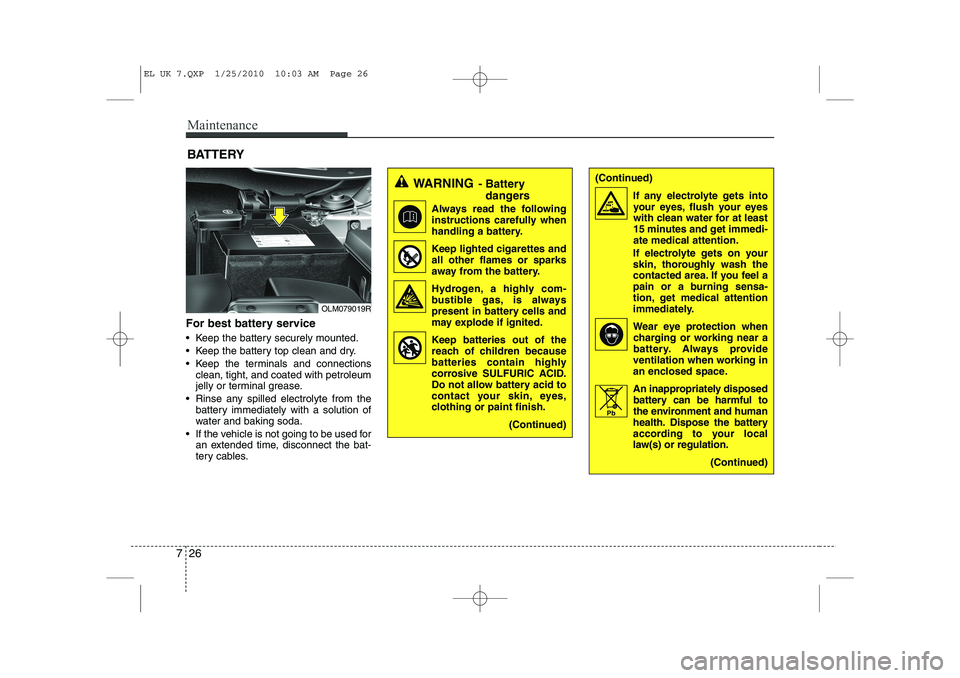
Maintenance
26
7
BATTERY
For best battery service
Keep the battery securely mounted.
Keep the battery top clean and dry.
Keep the terminals and connections clean, tight, and coated with petroleum
jelly or terminal grease.
Rinse any spilled electrolyte from the battery immediately with a solution of
water and baking soda.
If the vehicle is not going to be used for an extended time, disconnect the bat-
tery cables.
WARNING - Battery
dangers
Always read the following
instructions carefully when
handling a battery.
Keep lighted cigarettes and all other flames or sparks
away from the battery.
Hydrogen, a highly com- bustible gas, is always
present in battery cells and
may explode if ignited.
Keep batteries out of the reach of children because
batteries contain highly
corrosive SULFURIC ACID.
Do not allow battery acid to
contact your skin, eyes,
clothing or paint finish.
(Continued)(Continued)If any electrolyte gets intoyour eyes, flush your eyes
with clean water for at least
15 minutes and get immedi-ate medical attention.
If electrolyte gets on your
skin, thoroughly wash the
contacted area. If you feel a
pain or a burning sensa-
tion, get medical attention
immediately.
Wear eye protection when charging or working near a
battery. Always provide
ventilation when working in
an enclosed space.
An inappropriately disposed battery can be harmful to
the environment and human
health. Dispose the battery
according to your local
law(s) or regulation.
(Continued)
OLM079019R
Pb
EL UK 7.QXP 1/25/2010 10:03 AM Page 26
Page 357 of 560

737
Maintenance
4. Tyre ply composition and material
The number of layers or plies of rub-
ber-coated fabric are in the tyre. Tyre
manufacturers also must indicate the
materials in the tyre, which include
steel, nylon, polyester, and others.
The letter "R" means radial ply con-
struction; the letter "D" means diago-
nal or bias ply construction; and theletter "B" means belted-bias ply con-
struction.
5. Maximum permissible inflationpressure
This number is the greatest amount of air pressure that should be put in
the tyre. Do not exceed the maximum
permissible inflation pressure. Refer
to the Tyre and Loading Information
label for recommended inflation
pressure.
6. Maximum load rating
This number indicates the maximum
load in kilograms and pounds that
can be carried by the tyre. When
replacing the tyres on the vehicle,
always use a tyre that has the same
load rating as the factory installed
tyre.
7. Uniform tyre quality grading
Quality grades can be found where
applicable on the tyre sidewall
between tread shoulder and maxi-
mum section width.
For example:
TREADWEAR 200
TRACTION AA
TEMPERATURE A Tread wear
The tread wear grade is a compara-
tive rating based on the wear rate ofthe tyre when tested under controlled
conditions on a specified govern-
ment test course. For example, a tyre
graded 150 would wear one-and-a-
half times (1½) as well on the gov-
ernment course as a tyre graded100.
The relative performance of tyres depends upon the actual conditions
of their use, however, and may
depart significantly from the norm
because of variations in driving
habits, service practices and differ-
ences in road characteristics and cli-
mate.
These grades are molded on the
side-walls of passenger vehicle
tyres. The tyres available as standard
or optional equipment on your vehi-
cles may vary with respect to grade.
WARNING - Tyre age
Tyres degrade over time, even
when they are not being used.
Regardless of the remaining
tread, it is recommended that
tyres generally be replaced
after six (6) years of normal
service. Heat caused by hot cli-mates or frequent high loadingconditions can accelerate the
aging process. Failure to follow
this Warning can result in sud-
den tyre failure, which could
lead to a loss of control and an
accident involving serious
injury or death.
EL UK 7.QXP 1/25/2010 10:03 AM Page 37
Page 374 of 560
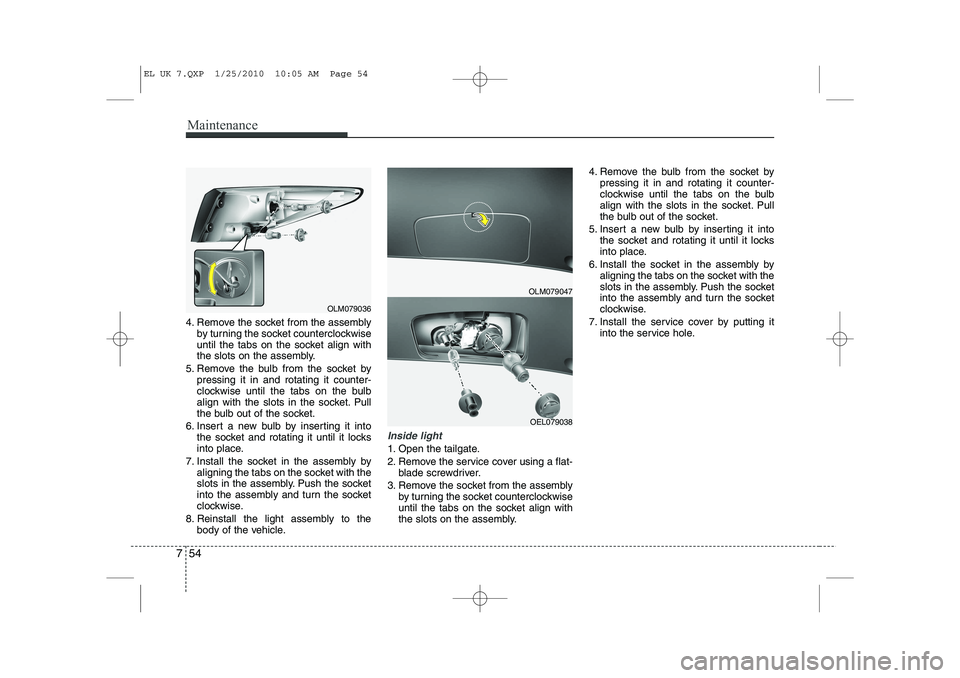
Maintenance
54
7
4. Remove the socket from the assembly
by turning the socket counterclockwise
until the tabs on the socket align with
the slots on the assembly.
5. Remove the bulb from the socket by pressing it in and rotating it counter-
clockwise until the tabs on the bulb
align with the slots in the socket. Pull
the bulb out of the socket.
6. Insert a new bulb by inserting it into the socket and rotating it until it locks
into place.
7. Install the socket in the assembly by aligning the tabs on the socket with the
slots in the assembly. Push the socket
into the assembly and turn the socket
clockwise.
8. Reinstall the light assembly to the body of the vehicle.
Inside light
1. Open the tailgate.
2. Remove the service cover using a flat-blade screwdriver.
3. Remove the socket from the assembly by turning the socket counterclockwise
until the tabs on the socket align with
the slots on the assembly. 4. Remove the bulb from the socket by
pressing it in and rotating it counter-
clockwise until the tabs on the bulb
align with the slots in the socket. Pull
the bulb out of the socket.
5. Insert a new bulb by inserting it into the socket and rotating it until it locks
into place.
6. Install the socket in the assembly by aligning the tabs on the socket with the
slots in the assembly. Push the socket
into the assembly and turn the socket
clockwise.
7. Install the service cover by putting it into the service hole.
OLM079047
OEL079038
OLM079036
EL UK 7.QXP 1/25/2010 10:05 AM Page 54
Page 383 of 560
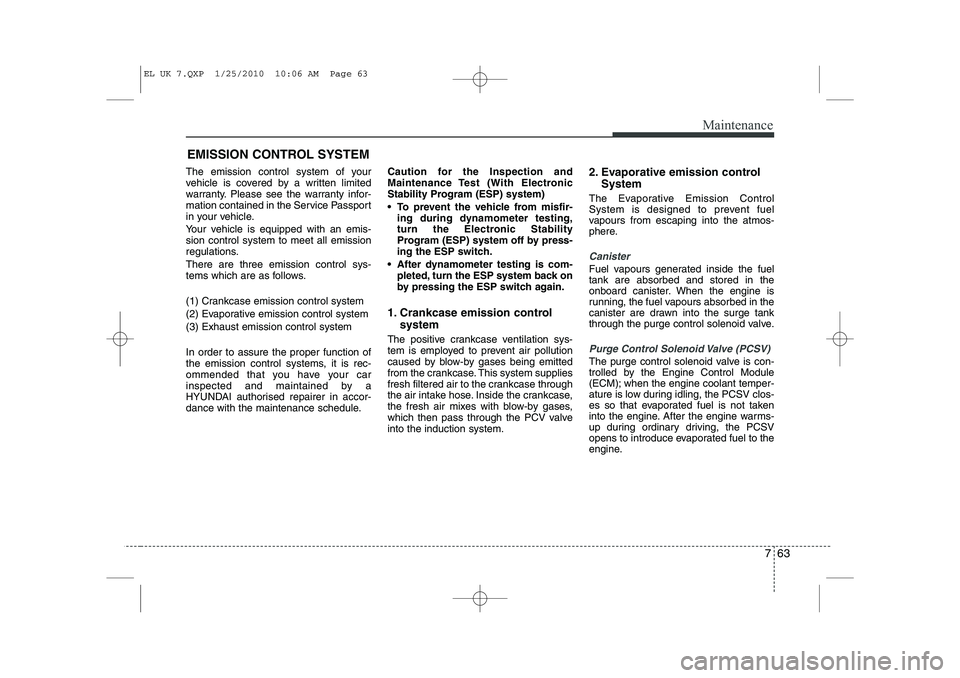
763
Maintenance
EMISSION CONTROL SYSTEM
The emission control system of your
vehicle is covered by a written limited
warranty. Please see the warranty infor-
mation contained in the Service Passport
in your vehicle.
Your vehicle is equipped with an emis- sion control system to meet all emission
regulations. There are three emission control sys-
tems which are as follows.
(1) Crankcase emission control system
(2) Evaporative emission control system(3) Exhaust emission control system In order to assure the proper function of
the emission control systems, it is rec-
ommended that you have your car
inspected and maintained by a
HYUNDAI authorised repairer in accor-
dance with the maintenance schedule. Caution for the Inspection and
Maintenance Test (With Electronic
Stability Program (ESP) system)
To prevent the vehicle from misfir-
ing during dynamometer testing,
turn the Electronic Stability
Program (ESP) system off by press-
ing the ESP switch.
After dynamometer testing is com- pleted, turn the ESP system back on
by pressing the ESP switch again.
1. Crankcase emission control system
The positive crankcase ventilation sys-
tem is employed to prevent air pollution
caused by blow-by gases being emitted
from the crankcase. This system supplies
fresh filtered air to the crankcase through
the air intake hose. Inside the crankcase,
the fresh air mixes with blow-by gases,
which then pass through the PCV valveinto the induction system. 2. Evaporative emission control
System
The Evaporative Emission Control
System is designed to prevent fuel
vapours from escaping into the atmos-
phere.
Canister
Fuel vapours generated inside the fuel tank are absorbed and stored in the
onboard canister. When the engine is
running, the fuel vapours absorbed in the
canister are drawn into the surge tank
through the purge control solenoid valve.
Purge Control Solenoid Valve (PCSV)
The purge control solenoid valve is con-
trolled by the Engine Control Module
(ECM); when the engine coolant temper-
ature is low during idling, the PCSV clos-
es so that evaporated fuel is not taken
into the engine. After the engine warms-
up during ordinary driving, the PCSV
opens to introduce evaporated fuel to the
engine.
EL UK 7.QXP 1/25/2010 10:06 AM Page 63
Page 398 of 560
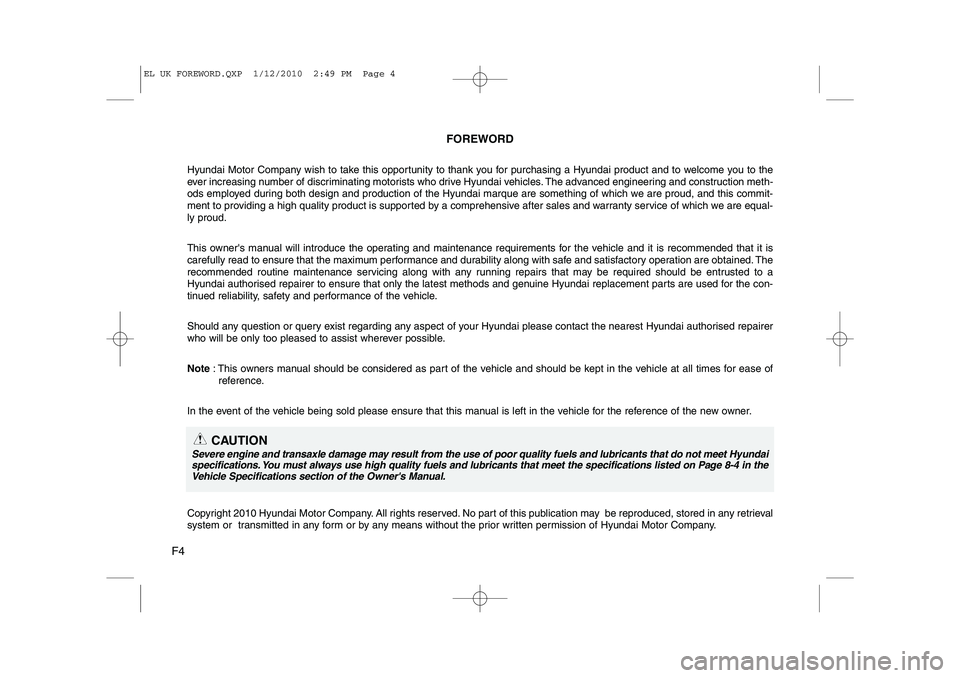
F4FOREWORD
Hyundai Motor Company wish to take this opportunity to thank you for purchasing a Hyundai product and to welcome you to the
ever increasing number of discriminating motorists who drive Hyundai vehicles. The advanced engineering and construction meth-
ods employed during both design and production of the Hyundai marque are something of which we are proud, and this commit-
ment to providing a high quality product is supported by a comprehensive after sales and warranty service of which we are equal -
ly proud.
This owner's manual will introduce the operating and maintenance requirements for the vehicle and it is recommended that it is
carefully read to ensure that the maximum performance and durability along with safe and satisfactory operation are obtained. Th e
recommended routine maintenance servicing along with any running repairs that may be required should be entrusted to a
Hyundai authorised repairer to ensure that only the latest methods and genuine Hyundai replacement parts are used for the con-
tinued reliability, safety and performance of the vehicle.
Should any question or query exist regarding any aspect of your Hyundai please contact the nearest Hyundai authorised repairer
who will be only too pleased to assist wherever possible. Note : This owners manual should be considered as part of the vehicle and should be kept in the vehicle at all times for ease of
reference.
In the event of the vehicle being sold please ensure that this manual is left in the vehicle for the reference of the new owner .
Copyright 2010 Hyundai Motor Company. All rights reserved. No part of this publication may be reproduced, stored in any retrieva l
system or transmitted in any form or by any means without the prior written permission of Hyundai Motor Company.
CAUTION
Severe engine and transaxle damage may result from the use of poor quality fuels and lubricants that do not meet Hyundai specifications. You must always use high quality fuels and lubricants that meet the specifications listed on Page 8-4 in the Vehicle Specifications section of the Owner's Manual.
EL UK FOREWORD.QXP 1/12/2010 2:49 PM Page 4
Page 408 of 560
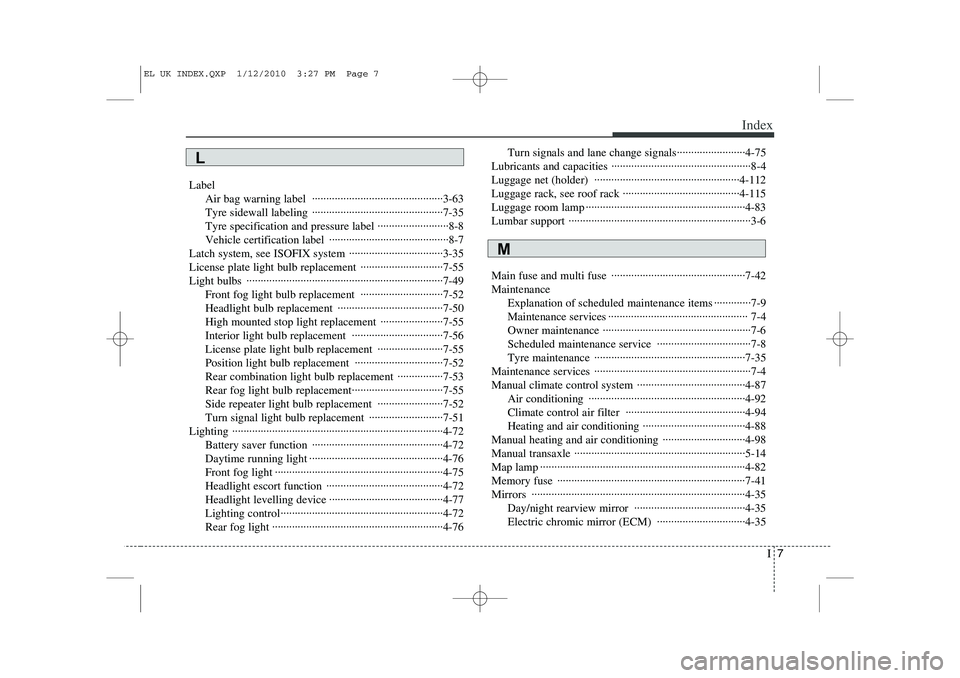
I7
Index
Label
Air bag warning label ··············································3-63
Tyre sidewall labeling ··············································7-35Tyre specification and pressure label ·························8-8
Vehicle certification label ··········································8-7
Latch system, see ISOFIX system ·································3-35
License plate light bulb replacement ·····························7-55
Light bulbs ·····································································7-49 Front fog light bulb replacement ·····························7-52
Headlight bulb replacement ·····································7-50
High mounted stop light replacement ······················7-55
Interior light bulb replacement ································7-56
License plate light bulb replacement ·······················7-55
Position light bulb replacement ·······························7-52
Rear combination light bulb replacement ················7-53
Rear fog light bulb replacement································7-55
Side repeater light bulb replacement ·······················7-52
Turn signal light bulb replacement ··························7-51
Lighting ··········································································4-72 Battery saver function ··············································4-72
Daytime running light ···············································4-76
Front fog light ···························································4-75
Headlight escort function ·········································4-72
Headlight levelling device ········································4-77
Lighting control·························································4-72
Rear fog light ····························································4-76 Turn signals and lane change signals························4-75
Lubricants and capacities ·················································8-4
Luggage net (holder) ···················································4-112Luggage rack, see roof rack ·········································4-115
Luggage room lamp ························································4-83
Lumbar support ································································3-6
Main fuse and multi fuse ···············································7-42 Maintenance Explanation of scheduled maintenance items ·············7-9Maintenance services ················································· 7-4
Owner maintenance ····················································7-6
Scheduled maintenance service ·································7-8
Tyre maintenance ·····················································7-35
Maintenance services ·······················································7-4
Manual climate control system ······································4-87 Air conditioning ·······················································4-92
Climate control air filter ··········································4-94
Heating and air conditioning ····································4-88
Manual heating and air conditioning ·····························4-98
Manual transaxle ····························································5-14
Map lamp ········································································4-82
Memory fuse ··································································7-41Mirrors ···········································································4-35 Day/night rearview mirror ·······································4-35
Electric chromic mirror (ECM) ·······························4-35
L
M
EL UK INDEX.QXP 1/12/2010 3:27 PM Page 7
Page 410 of 560
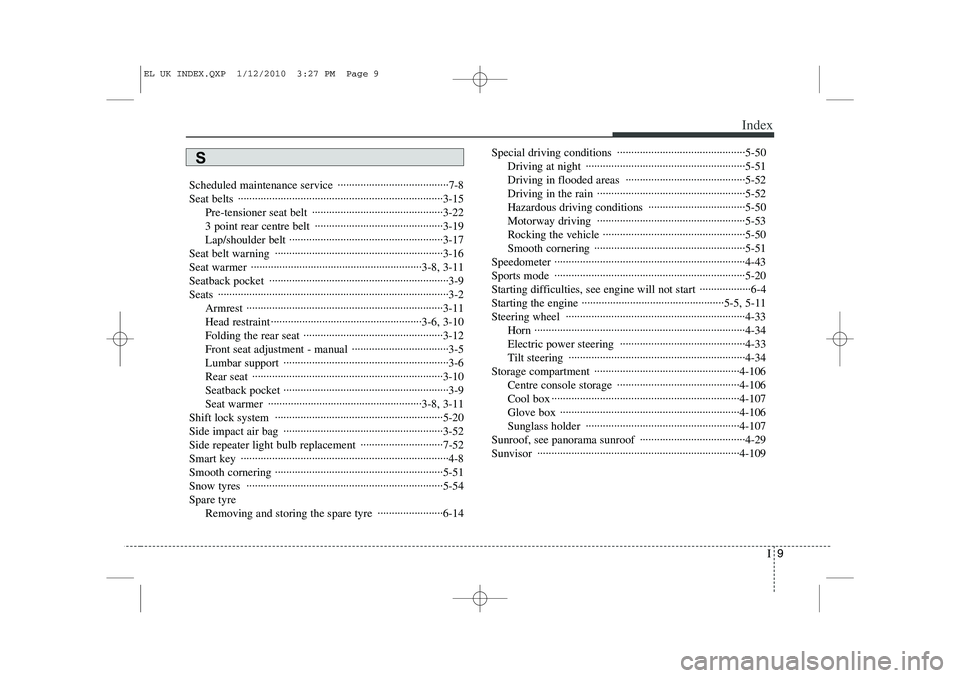
I9
Index
Scheduled maintenance service ·······································7-8
Seat belts ········································································3-15
Pre-tensioner seat belt ··············································3-22
3 point rear centre belt ·············································3-19
Lap/shoulder belt ······················································3-17
Seat belt warning ···························································3-16
Seat warmer ····························································3-8, 3-11
Seatback pocket ·······························································3-9Seats ·················································································3-2 Armrest ·····································································3-11
Head restraint ·····················································3-6, 3-10
Folding the rear seat ·················································3-12
Front seat adjustment - manual ··································3-5
Lumbar support ··························································3-6
Rear seat ···································································3-10
Seatback pocket ··························································3-9
Seat warmer ······················································3-8, 3-11
Shift lock system ···························································5-20
Side impact air bag ························································3-52
Side repeater light bulb replacement ·····························7-52
Smart key ·········································································4-8
Smooth cornering ···························································5-51
Snow tyres ·····································································5-54Spare tyre Removing and storing the spare tyre ·······················6-14 Special driving conditions ·············································5-50
Driving at night ························································5-51
Driving in flooded areas ··········································5-52
Driving in the rain ····················································5-52
Hazardous driving conditions ··································5-50
Motorway driving ····················································5-53
Rocking the vehicle ··················································5-50
Smooth cornering ·····················································5-51
Speedometer ···································································4-43
Sports mode ···································································5-20
Starting difficulties, see engine will not start ··················6-4
Starting the engine ··················································5-5, 5-11
Steering wheel ·······························································4-33 Horn ··········································································4-34
Electric power steering ············································4-33
Tilt steering ······························································4-34
Storage compartment ···················································4-106 Centre console storage ···········································4-106
Cool box ··································································4-107
Glove box ·······························································4-106
Sunglass holder ······················································4-107
Sunroof, see panorama sunroof ·····································4-29Sunvisor ·······································································4-109
S
EL UK INDEX.QXP 1/12/2010 3:27 PM Page 9